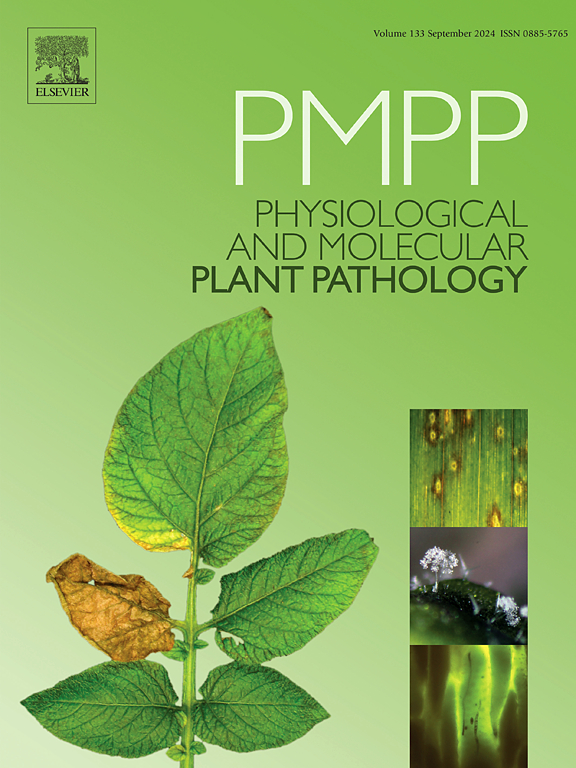Lasiodiplodia theobromae and Lasiodiplodia brasiliensis associated with dieback and canker in cupuaçu trees (Theobroma grandiflorum) in Brazil
IF 2.8
3区 农林科学
Q2 PLANT SCIENCES
引用次数: 0
Abstract
Cupuaçu (Theobroma grandiflorum) is a tropical fruit tree native to Northern Brazil. For decades, dieback symptoms have been observed in cupuaçu trees, leading to significant reductions in productivity. Between 2019 and 2020, during phytosanitary surveys conducted in orchards across the states of Acre and Amazonas, fungal isolates belonging to the Botryosphaeriaceae family were collected from the wood tissues of symptomatic plants. Based on morphological and multigenic analyses (TEF1-α, ITS, and TUB2), the isolates were classified as Lasiodiplodia theobromae and L. brasiliensis. Disease incidence was estimated at 15 % among plants showing canker and dieback symptoms, from which 20 isolates were obtained. Seven representative isolates from three distinct geographic regions were selected for species identification and pathogenicity testing. Multilocus phylogenetic analysis revealed that four isolates clustered with the reference strain of L. theobromae, while three clustered with L. brasiliensis. Pathogenicity tests demonstrated that both species were capable of inducing canker symptoms and dark lesions on wood tissues. This study is the first report of L. theobromae and L. brasiliensis causing dieback and canker on cupuaçu trees in Brazil.
巴西大桔梗树(Theobroma grande florum)枯死和溃疡病的相关疾病
cupuaaperu (Theobroma grandflorum)是一种原产于巴西北部的热带果树。几十年来,在cupuaparusu树中观察到枯死症状,导致生产力显著降低。2019年至2020年期间,在阿克里州和亚马逊州的果园进行植物检疫调查期间,从有症状植物的木材组织中收集了属于Botryosphaeriaceae家族的真菌分离物。基于形态学和多基因分析(TEF1-α、ITS和TUB2),将分离菌株分类为可可Lasiodiplodia theobromae和巴西乳杆菌(L. brasiliensis)。在表现溃烂和枯死症状的植物中,疾病发病率估计为15%,从中获得了20株分离株。从3个不同地理区域选取7株具有代表性的分离株进行物种鉴定和致病性试验。多位点系统发育分析显示,4株分离株与参考菌株聚类,3株与巴西乳杆菌聚类。致病性试验表明,这两个物种都能引起木材组织的溃烂症状和深色病变。本研究首次报道了在巴西引起cupuaparsuu树木枯死和溃疡病的L. theobromae和L. brasiliensis。
本文章由计算机程序翻译,如有差异,请以英文原文为准。
求助全文
约1分钟内获得全文
求助全文
来源期刊
CiteScore
4.30
自引率
7.40%
发文量
130
审稿时长
38 days
期刊介绍:
Physiological and Molecular Plant Pathology provides an International forum for original research papers, reviews, and commentaries on all aspects of the molecular biology, biochemistry, physiology, histology and cytology, genetics and evolution of plant-microbe interactions.
Papers on all kinds of infective pathogen, including viruses, prokaryotes, fungi, and nematodes, as well as mutualistic organisms such as Rhizobium and mycorrhyzal fungi, are acceptable as long as they have a bearing on the interaction between pathogen and plant.

 求助内容:
求助内容: 应助结果提醒方式:
应助结果提醒方式:


